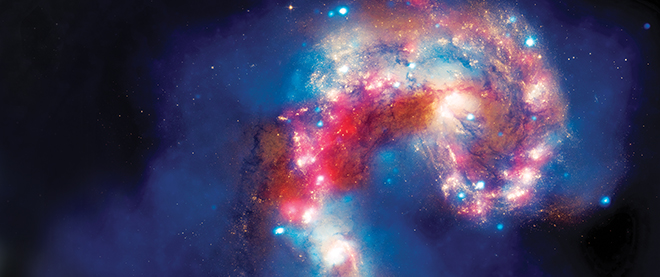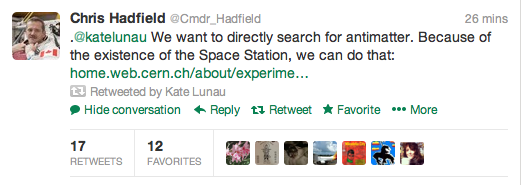Big news on dark matter? Soon, scientists promise. Real soon.
Kate Lunau’s latest from the AAAS Meeting, on the mysterious stuff that makes up 25 per cent of our universe
NASA
Share

Kate Lunau is in Boston covering the 2013 annual meeting of the American Association for the Advancement of Science (AAAS), where some of the world’s finest brains and celebrities of science meet to mix, mingle, and share their latest and greatest ideas. On Feb. 14-18, she’ll give you a sneak peak into the current research—everything from dinosaurs to neutrinos, from stem cells to extreme weather, and all sorts of sorts of stuff in between. Follow her on Twitter: @katelunau, #AAASmtg
The International Space Station isn’t just home to astronauts like Canadian Chris Hadfield, who’ll assume command in a few weeks’ time. It’s also an orbiting laboratory: hundreds of experiments are done there, looking into everything from human health to colloids. The ISS holds a $2-billion particle physics detector, called the Alpha Magnetic Spectrometer, which is searching for signs of exotic stuff that makes up our universe, like dark matter. Big news might be coming soon. At the AAAS Meeting, Nobel laureate and AMS principal investigator Dr. Samuel Ting promised that the first results from the AMS detector should be published in two or three weeks’ time. “It will not be a minor paper,” he told a crowded room of reporters.
Dark matter is a mysterious substance believed to make up about 25 per cent of our universe (dark energy, something even weirder, accounts for more than 70 per cent—a scant 4 per cent of our universe is made up of the matter we know and understand). Scientists have been on the hunt for dark matter for decades, at places like the Large Hadron Collider, but so far have come up empty-handed. At his talk in Boston today, Ting explained why searching aboard the ISS is ideal. “The Cosmos is the ultimate lab,” he said. In space, “cosmic rays can be observed at energies higher than any accelerator.”
Since its installation in 2011, the AMS has recorded about 25 billion cosmic ray signals, including close to 8 million electrons and positrons (their antimatter counterparts). The ratio of electrons to positrons is a crucial piece of information, and this is what Ting’s upcoming paper is about: when dark matter particles annihilate in space, they might leave extra positrons behind. It’s impossible to say what Ting’s paper will show, and despite being hounded by reporters, he remained coy. But he did note that this is just the beginning: the data collected so far represents only 8 per cent of what the AMS should deliver, as it’s scheduled to run through to 2028, along with the ISS.
Ting noted that the history of physics discovery is one of surprise. The AMS is searching for dark matter, antimatter and strangelets; but in the final slide of Ting’s presentation, to illustrate what it would find, there was only a question mark.
Just moments ago, astronaut Chris Hadfield had this to add to the conversation:
